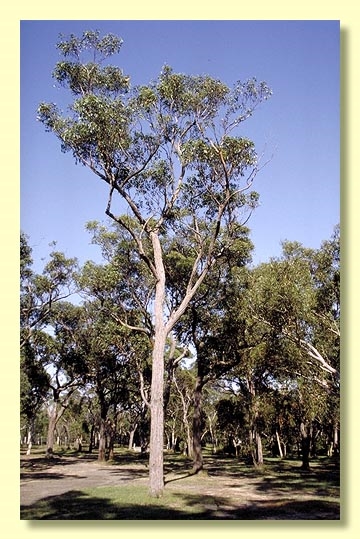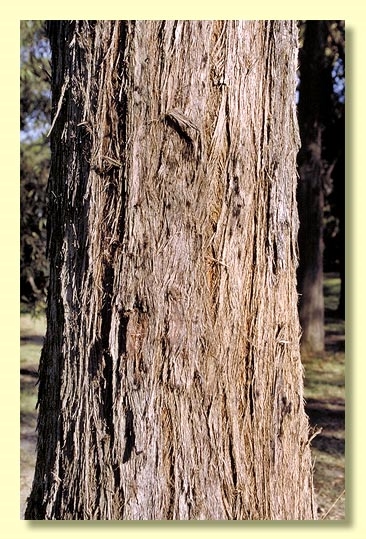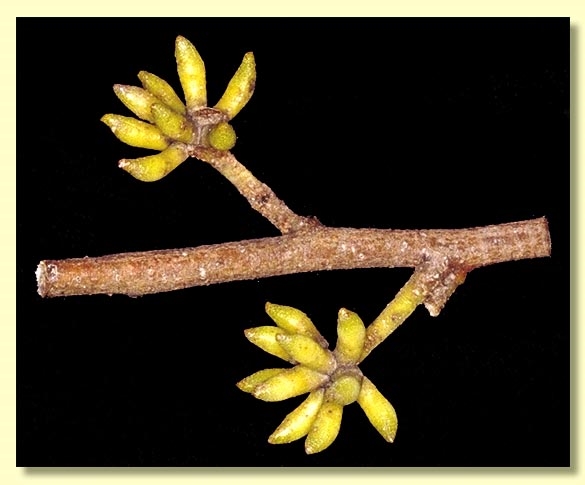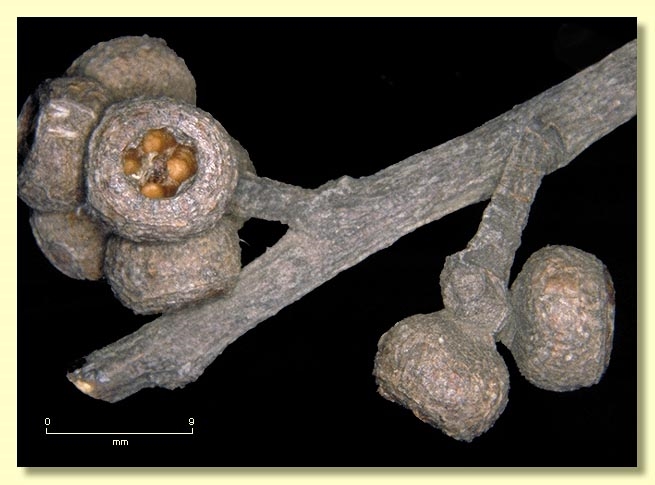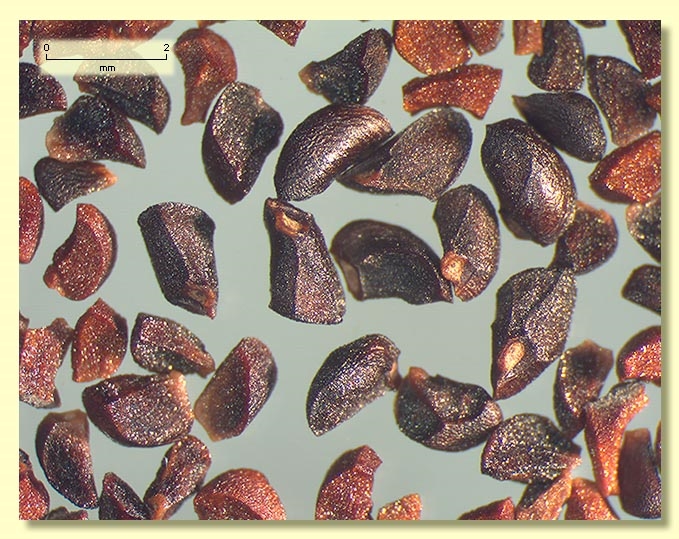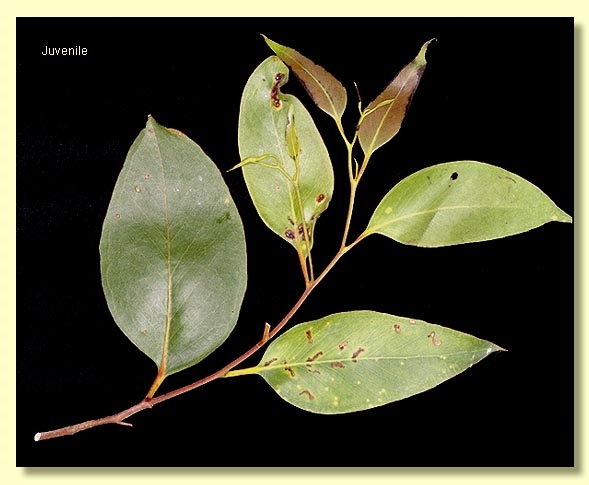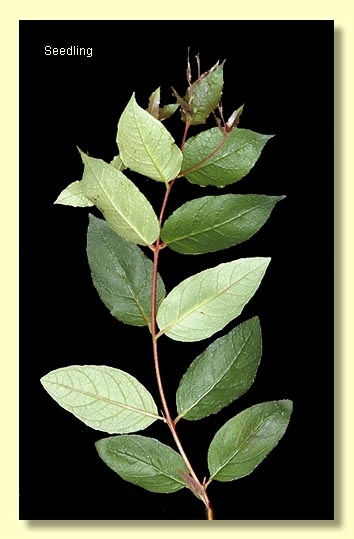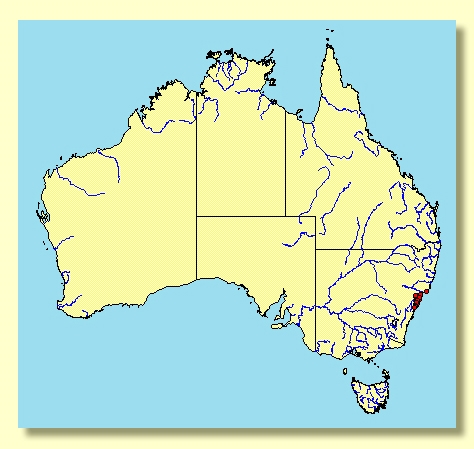Euclid - Online edition
Eucalyptus capitellata
Eucalyptus | Eucalyptus | Capillulus | Pachyphloius
Tree to 25 m tall. Forming a lignotuber.
Bark rough to small branches, stringy, grey or grey-brown.
Juvenile growth (coppice or field seedlings to 50 cm): stems round in cross-section, scabrid; juvenile leaves sessile to shortly petiolate (petioles 0.3–0.6 cm), opposite for 4 to 6 nodes then alternate, ovate to broadly lanceolate, 5.5–8.0 cm long, 2.5–4.0 cm wide, bases tapering or rounded, margin entire, lower leaves discolorous, glossy, green, scabrid only near the underside, upper leaves of coppice soon becoming glabrous, concolorous and thickish. Intermediate leaves very large to ca 15 cm long, 6–8 cm wide.
Adult leaves alternate, petiole 0.8–2 cm long; blade broadly lanceolate to lanceolate or falcate, 8–13 cm long, 2–3.5 cm wide, base oblique, concolorous, glossy, green, side-veins acute, sparsely reticulate, intramarginal vein parallel to and well-removed from margin, oil glands, numerous, irregular, island.
Inflorescence axillary unbranched, peduncles 1.5–2 cm long, buds 7 to ?15 per umbel, usually sessile (rarely pedicels to 0.2 cm). Mature buds buds fusiform to oblong, 0.6–0.8 cm long, 0.3–0.4 cm wide, yellowish, smooth, often longitudinally angled, scar absent, operculum conical, stamens irregularly flexed, anthers reniform to cordate, versatile, dorsifixed, dehiscing by confluent slits, style long, stigma tapered, locules 3 or 4, the placentae each with 2 vertical ovule rows. Flowers white.
Fruit sessile, flattened-hemispherical, 0.4–0.7 cm long, 0.7–1 cm wide, clustered together but not laterally deformed, disc raised-convex, valves 3 or 4, near rim level.
Seeds dark brown to grey, 1.8–2.7 mm long, pyramidal or obliquely pyramidal, dorsal surface smooth, hilum terminal.
Cultivated seedlings (measured at ca node 10): cotyledons reniform; stems rounded in cross-section, densely stellate-hairy; leaves always petiolate, opposite for 4 to 6 nodes then alternate, ovate to lanceolate, 4–8 cm long, 2–4.5 cm wide, base rounded to tapering or oblique, margin irregular due to hairs, apex pointed, discolorous, darker green and glossy above, paler beneath. Stems and leaves scabrid with stellate hairs to at least node 10, but leaves virtually glabrous above, sparsely hairy below whilst the petiole and midrib have most hairs.
Flowering has been recorded in January, February, August, September and December.
A small to medium-sized stringybark tree of central coastal New South Wales with a few occurrences on more elevated sites. It is usually found on poor sandy soils over sandstone but also may occur on slightly deeper, heavier-textured soils over shales. Eucalyptus capitellata is distinguished by the rough bark extending to the small branches, thick glossy green adult leaves, buds with pointed opercula and tightly clustered flattened-hemispherical fruit. Juvenile leaves are ovate to broadly lanceolate with tapering to rounded bases and are predominantly glabrous.
E. capitellata is similar to and often confused with the more stunted E. camfieldii, which differs primarily in the orbicular always mucronate seedling and juvenile leaves with lobed or cordate leaf bases. E. agglomerata differs from E. capitellata in the bluish green crown, larger ovate juvenile leaves and fruit so tightly clustered that the sides are deformed (laterally compressed). At slightly higher elevations E. blaxlandii could be confused with E. capitellata, but the former has whitish smooth branches in the crown and buds with blunt opercula. Other species of stringybark in this area lack the tightly clustered sessile flattened-hemispherical fruit.
MORE ABOUT STRINGYBARKS

